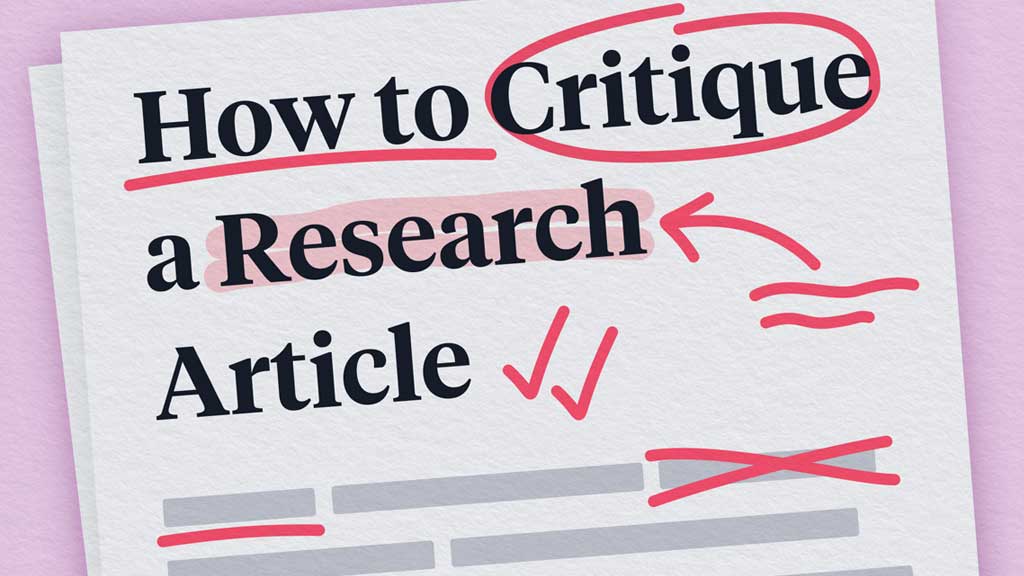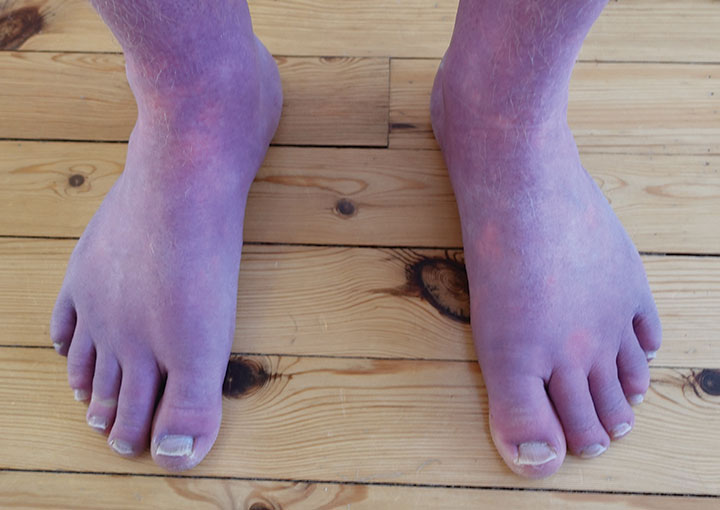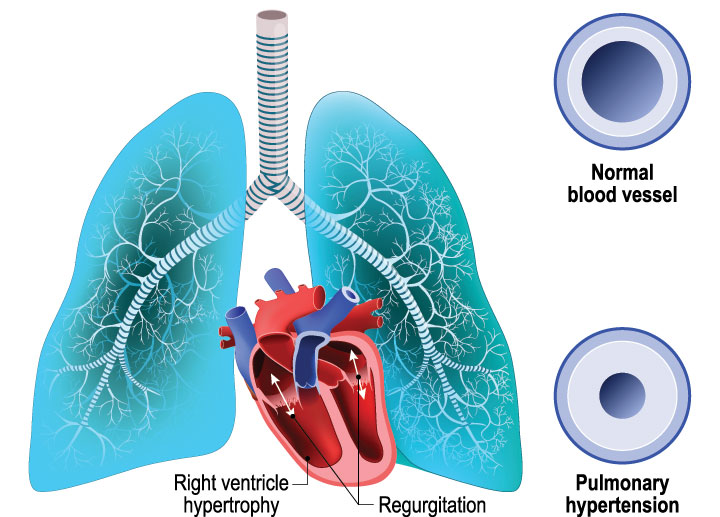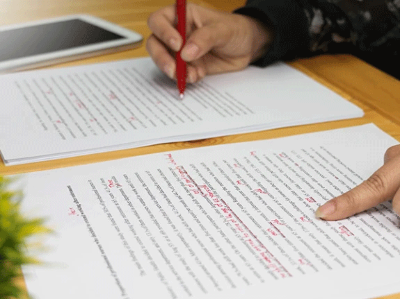How to Write an Article Critique Step-by-Step
Table of contents
- 1 What is an Article Critique Writing?
- 2 How to Critique an Article: The Main Steps
- 3 Article Critique Outline
- 4 Article Critique Formatting
- 5 How to Write a Journal Article Critique
- 6 How to Write a Research Article Critique
- 7 Research Methods in Article Critique Writing
- 8 Tips for writing an Article Critique
Do you know how to critique an article? If not, don’t worry – this guide will walk you through the writing process step-by-step. First, we’ll discuss what a research article critique is and its importance. Then, we’ll outline the key points to consider when critiquing a scientific article. Finally, we’ll provide a step-by-step guide on how to write an article critique including introduction, body and summary. Read more to get the main idea of crafting a critique paper.

What is an Article Critique Writing?
An article critique is a formal analysis and evaluation of a piece of writing. It is often written in response to a particular text but can also be a response to a book, a movie, or any other form of writing. There are many different types of review articles . Before writing an article critique, you should have an idea about each of them.
To start writing a good critique, you must first read the article thoroughly and examine and make sure you understand the article’s purpose. Then, you should outline the article’s key points and discuss how well they are presented. Next, you should offer your comments and opinions on the article, discussing whether you agree or disagree with the author’s points and subject. Finally, concluding your critique with a brief summary of your thoughts on the article would be best. Ensure that the general audience understands your perspective on the piece.
How to Critique an Article: The Main Steps
If you are wondering “what is included in an article critique,” the answer is:
An article critique typically includes the following:
- A brief summary of the article .
- A critical evaluation of the article’s strengths and weaknesses.
- A conclusion.
When critiquing an article, it is essential to critically read the piece and consider the author’s purpose and research strategies that the author chose. Next, provide a brief summary of the text, highlighting the author’s main points and ideas. Critique an article using formal language and relevant literature in the body paragraphs. Finally, describe the thesis statement, main idea, and author’s interpretations in your language using specific examples from the article. It is also vital to discuss the statistical methods used and whether they are appropriate for the research question. Make notes of the points you think need to be discussed, and also do a literature review from where the author ground their research. Offer your perspective on the article and whether it is well-written. Finally, provide background information on the topic if necessary.
When you are reading an article, it is vital to take notes and critique the text to understand it fully and to be able to use the information in it. Here are the main steps for critiquing an article:
- Read the piece thoroughly, taking notes as you go. Ensure you understand the main points and the author’s argument.
- Take a look at the author’s perspective. Is it powerful? Does it back up the author’s point of view?
- Carefully examine the article’s tone. Is it biased? Are you being persuaded by the author in any way?
- Look at the structure. Is it well organized? Does it make sense?
- Consider the writing style. Is it clear? Is it well-written?
- Evaluate the sources the author uses. Are they credible?
- Think about your own opinion. With what do you concur or disagree? Why?

Article Critique Outline
When assigned an article critique, your instructor asks you to read and analyze it and provide feedback. A specific format is typically followed when writing an article critique.
An article critique usually has three sections: an introduction, a body, and a conclusion.
- The introduction of your article critique should have a summary and key points.
- The critique’s main body should thoroughly evaluate the piece, highlighting its strengths and weaknesses, and state your ideas and opinions with supporting evidence.
- The conclusion should restate your research and describe your opinion.
You should provide your analysis rather than simply agreeing or disagreeing with the author. When writing an article review , it is essential to be objective and critical. Describe your perspective on the subject and create an article review summary. Be sure to use proper grammar, spelling, and punctuation, write it in the third person, and cite your sources.
Article Critique Formatting
When writing an article critique, you should follow a few formatting guidelines. The importance of using a proper format is to make your review clear and easy to read.
Make sure to use double spacing throughout your critique. It will make it easy to understand and read for your instructor.
Indent each new paragraph. It will help to separate your critique into different sections visually.
Use headings to organize your critique. Your introduction, body, and conclusion should stand out. It will make it easy for your instructor to follow your thoughts.
Use standard fonts, such as Times New Roman or Arial. It will make your critique easy to read.
Use 12-point font size. It will ensure that your critique is easy to read.

How to Write a Journal Article Critique
When critiquing a journal article, there are a few key points to keep in mind:
- Good critiques should be objective, meaning that the author’s ideas and arguments should be evaluated without personal bias.
- Critiques should be critical, meaning that all aspects of the article should be examined, including the author’s introduction, main ideas, and discussion.
- Critiques should be informative, providing the reader with a clear understanding of the article’s strengths and weaknesses.
When critiquing a research article, evaluating the author’s argument and the evidence they present is important. The author should state their thesis or the main point in the introductory paragraph. You should explain the article’s main ideas and evaluate the evidence critically. In the discussion section, the author should explain the implications of their findings and suggest future research.
It is also essential to keep a critical eye when reading scientific articles. In order to be credible, the scientific article must be based on evidence and previous literature. The author’s argument should be well-supported by data and logical reasoning.
How to Write a Research Article Critique
When you are assigned a research article, the first thing you need to do is read the piece carefully. Make sure you understand the subject matter and the author’s chosen approach. Next, you need to assess the importance of the author’s work. What are the key findings, and how do they contribute to the field of research?
Finally, you need to provide a critical point-by-point analysis of the article. This should include discussing the research questions, the main findings, and the overall impression of the scientific piece. In conclusion, you should state whether the text is good or bad. Read more to get an idea about curating a research article critique. But if you are not confident, you can ask “ write my papers ” and hire a professional to craft a critique paper for you. Explore your options online and get high-quality work quickly.
However, test yourself and use the following tips to write a research article critique that is clear, concise, and properly formatted.
- Take notes while you read the text in its entirety. Right down each point you agree and disagree with.
- Write a thesis statement that concisely and clearly outlines the main points.
- Write a paragraph that introduces the article and provides context for the critique.
- Write a paragraph for each of the following points, summarizing the main points and providing your own analysis:
- The purpose of the study
- The research question or questions
- The methods used
- The outcomes
- The conclusions were drawn by the author(s)
- Mention the strengths and weaknesses of the piece in a separate paragraph.
- Write a conclusion that summarizes your thoughts about the article.
- Free unlimited checks
- All common file formats
- Accurate results
- Intuitive interface
Research Methods in Article Critique Writing
When writing an article critique, it is important to use research methods to support your arguments. There are a variety of research methods that you can use, and each has its strengths and weaknesses. In this text, we will discuss four of the most common research methods used in article critique writing: quantitative research, qualitative research, systematic reviews, and meta-analysis.
Quantitative research is a research method that uses numbers and statistics to analyze data. This type of research is used to test hypotheses or measure a treatment’s effects. Quantitative research is normally considered more reliable than qualitative research because it considers a large amount of information. But, it might be difficult to find enough data to complete it properly.
Qualitative research is a research method that uses words and interviews to analyze data. This type of research is used to understand people’s thoughts and feelings. Qualitative research is usually more reliable than quantitative research because it is less likely to be biased. Though it is more expensive and tedious.
Systematic reviews are a type of research that uses a set of rules to search for and analyze studies on a particular topic. Some think that systematic reviews are more reliable than other research methods because they use a rigorous process to find and analyze studies. However, they can be pricy and long to carry out.
Meta-analysis is a type of research that combines several studies’ results to understand a treatment’s overall effect better. Meta-analysis is generally considered one of the most reliable type of research because it uses data from several approved studies. Conversely, it involves a long and costly process.
Are you still struggling to understand the critique of an article concept? You can contact an online review writing service to get help from skilled writers. You can get custom, and unique article reviews easily.

Tips for writing an Article Critique
It’s crucial to keep in mind that you’re not just sharing your opinion of the content when you write an article critique. Instead, you are providing a critical analysis, looking at its strengths and weaknesses. In order to write a compelling critique, you should follow these tips: Take note carefully of the essential elements as you read it.
- Make sure that you understand the thesis statement.
- Write down your thoughts, including strengths and weaknesses.
- Use evidence from to support your points.
- Create a clear and concise critique, making sure to avoid giving your opinion.
It is important to be clear and concise when creating an article critique. You should avoid giving your opinion and instead focus on providing a critical analysis. You should also use evidence from the article to support your points.
Readers also enjoyed

WHY WAIT? PLACE AN ORDER RIGHT NOW!
Just fill out the form, press the button, and have no worries!
We use cookies to give you the best experience possible. By continuing we’ll assume you board with our cookie policy.
- All eBooks & Audiobooks
- Academic eBook Collection
- Home Grown eBook Collection
- Off-Campus Access
- Literature Resource Center
- Opposing Viewpoints
- ProQuest Central
- Course Guides
- Citing Sources
- Library Research
- Websites by Topic
- Book-a-Librarian
- Research Tutorials
- Use the Catalog
- Use Databases
- Use Films on Demand
- Use Home Grown eBooks
- Use NC LIVE
- Evaluating Sources
- Primary vs. Secondary
- Scholarly vs. Popular
- Make an Appointment
- Writing Tools
- Annotated Bibliographies
- Summaries, Reviews & Critiques
- Writing Center
Service Alert

Article Summaries, Reviews & Critiques
- Writing an article SUMMARY
- Writing an article REVIEW
Writing an article CRITIQUE
- Citing Sources This link opens in a new window
- About RCC Library
Text: 336-308-8801
Email: [email protected]
Call: 336-633-0204
Schedule: Book-a-Librarian
Like us on Facebook
Links on this guide may go to external web sites not connected with Randolph Community College. Their inclusion is not an endorsement by Randolph Community College and the College is not responsible for the accuracy of their content or the security of their site.
A critique asks you to evaluate an article and the author’s argument. You will need to look critically at what the author is claiming, evaluate the research methods, and look for possible problems with, or applications of, the researcher’s claims.
Introduction
Give an overview of the author’s main points and how the author supports those points. Explain what the author found and describe the process they used to arrive at this conclusion.
Body Paragraphs
Interpret the information from the article:
- Does the author review previous studies? Is current and relevant research used?
- What type of research was used – empirical studies, anecdotal material, or personal observations?
- Was the sample too small to generalize from?
- Was the participant group lacking in diversity (race, gender, age, education, socioeconomic status, etc.)
- For instance, volunteers gathered at a health food store might have different attitudes about nutrition than the population at large.
- How useful does this work seem to you? How does the author suggest the findings could be applied and how do you believe they could be applied?
- How could the study have been improved in your opinion?
- Does the author appear to have any biases (related to gender, race, class, or politics)?
- Is the writing clear and easy to follow? Does the author’s tone add to or detract from the article?
- How useful are the visuals (such as tables, charts, maps, photographs) included, if any? How do they help to illustrate the argument? Are they confusing or hard to read?
- What further research might be conducted on this subject?
Try to synthesize the pieces of your critique to emphasize your own main points about the author’s work, relating the researcher’s work to your own knowledge or to topics being discussed in your course.
From the Center for Academic Excellence (opens in a new window), University of Saint Joseph Connecticut
Additional Resources
All links open in a new window.
Writing an Article Critique (from The University of Arizona Global Campus Writing Center)
How to Critique an Article (from Essaypro.com)
How to Write an Article Critique (from EliteEditing.com.au)
- << Previous: Writing an article REVIEW
- Next: Citing Sources >>
- Last Updated: Mar 15, 2024 9:32 AM
- URL: https://libguides.randolph.edu/summaries
You are using an outdated browser
Unfortunately Ausmed.com does not support your browser. Please upgrade your browser to continue.
How to Critique a Research Article
Published: 01 October 2023

Let's briefly examine some basic pointers on how to perform a literature review.
If you've managed to get your hands on peer-reviewed articles, then you may wonder why it is necessary for you to perform your own article critique. Surely the article will be of good quality if it has made it through the peer-review process?
Unfortunately, this is not always the case.
Publication bias can occur when editors only accept manuscripts that have a bearing on the direction of their own research, or reject manuscripts with negative findings. Additionally, not all peer reviewers have expert knowledge on certain subject matters , which can introduce bias and sometimes a conflict of interest.
Performing your own critical analysis of an article allows you to consider its value to you and to your workplace.
Critical evaluation is defined as a systematic way of considering the truthfulness of a piece of research, its results and how relevant and applicable they are.
How to Critique
It can be a little overwhelming trying to critique an article when you're not sure where to start. Considering the article under the following headings may be of some use:
Title of Study/Research
You may be a better judge of this after reading the article, but the title should succinctly reflect the content of the work, stimulating readers' interest.
Three to six keywords that encapsulate the main topics of the research will have been drawn from the body of the article.
Introduction
This should include:
- Evidence of a literature review that is relevant and recent, critically appraising other works rather than merely describing them
- Background information on the study to orientate the reader to the problem
- Hypothesis or aims of the study
- Rationale for the study that justifies its need, i.e. to explore an un-investigated gap in the literature.

Materials and Methods
Similar to a recipe, the description of materials and methods will allow others to replicate the study elsewhere if needed. It should both contain and justify the exact specifications of selection criteria, sample size, response rate and any statistics used. This will demonstrate how the study is capable of achieving its aims. Things to consider in this section are:
- What sort of sampling technique and size was used?
- What proportion of the eligible sample participated? (e.g. '553 responded to a survey sent to 750 medical technologists'
- Were all eligible groups sampled? (e.g. was the survey sent only in English?)
- What were the strengths and weaknesses of the study?
- Were there threats to the reliability and validity of the study, and were these controlled for?
- Were there any obvious biases?
- If a trial was undertaken, was it randomised, case-controlled, blinded or double-blinded?
Results should be statistically analysed and presented in a way that an average reader of the journal will understand. Graphs and tables should be clear and promote clarity of the text. Consider whether:
- There were any major omissions in the results, which could indicate bias
- Percentages have been used to disguise small sample sizes
- The data generated is consistent with the data collected.
Negative results are just as relevant as research that produces positive results (but, as mentioned previously, may be omitted in publication due to editorial bias).
This should show insight into the meaning and significance of the research findings. It should not introduce any new material but should address how the aims of the study have been met. The discussion should use previous research work and theoretical concepts as the context in which the new study can be interpreted. Any limitations of the study, including bias, should be clearly presented. You will need to evaluate whether the author has clearly interpreted the results of the study, or whether the results could be interpreted another way.
Conclusions
These should be clearly stated and will only be valid if the study was reliable, valid and used a representative sample size. There may also be recommendations for further research.
These should be relevant to the study, be up-to-date, and should provide a comprehensive list of citations within the text.
Final Thoughts
Undertaking a critique of a research article may seem challenging at first, but will help you to evaluate whether the article has relevance to your own practice and workplace. Reading a single article can act as a springboard into researching the topic more widely, and aids in ensuring your nursing practice remains current and is supported by existing literature.
- Marshall, G 2005, ‘Critiquing a Research Article’, Radiography , vol. 11, no. 1, viewed 2 October 2023, https://www.radiographyonline.com/article/S1078-8174(04)00119-1/fulltext
Sarah Vogel View profile
Help and feedback, publications.
Ausmed Education is a Trusted Information Partner of Healthdirect Australia. Verify here .

SPH Writing Support Services
- Appointment System
- ESL Conversation Group
- Mini-Courses
- Thesis/Dissertation Writing Group
- Career Writing
- Citing Sources
- Critiquing Research Articles
- Project Planning for the Beginner This link opens in a new window
- Grant Writing
- Publishing in the Sciences
- Systematic Review Overview
- Systematic Review Resources This link opens in a new window
- Writing Across Borders / Writing Across the Curriculum
- Conducting an article critique for a quantitative research study: Perspectives for doctoral students and other novice readers (Vance et al.)
- Critique Process (Boswell & Cannon)
- The experience of critiquing published research: Learning from the student and researcher perspective (Knowles & Gray)
- A guide to critiquing a research paper. Methodological appraisal of a paper on nurses in abortion care (Lipp & Fothergill)
- Step-by-step guide to critiquing research. Part 1: Quantitative research (Coughlan et al.)
- Step-by-step guide to critiquing research. Part 2: Qualitative research (Coughlan et al.)
Guidelines:
- Critiquing Research Articles (Flinders University)
- Framework for How to Read and Critique a Research Study (American Nurses Association)
- How to Critique a Journal Article (UIS)
- How to Critique a Research Paper (University of Michigan)
- How to Write an Article Critique
- Research Article Critique Form
- Writing a Critique or Review of a Research Article (University of Calgary)
Presentations:
- The Critique Process: Reviewing and Critiquing Research
- Writing a Critique
- << Previous: Citing Sources
- Next: Project Planning for the Beginner >>
- Last Updated: Apr 30, 2024 12:52 PM
- URL: https://libguides.sph.uth.tmc.edu/writing_support_services

Reading and Critiquing Research
- Resources for Critiquing
- Structure of a Research Article
- Tips for Reading a Journal Article
- At a loss for words?
Additional Research Starters
- Literature Reviews by Cynthia Hunt Last Updated Jun 26, 2023 32 views this year
Assistant Director of Library Services

Reading & Critiquing Research Articles
Reading and critiquing scholarly research articles is a skill developed with time and practice. As you read more within your discipline you'll likely discover patterns in the structure of the journal articles. You'll also get more experienced at differentiating between good and bad articles.
Critique is a synonym for evaluation. A critique is a critical analysis or evaluation of a subject, situation, literary work, or other type of evaluand. It is critical in the sense of being characterized by careful analysis and judgment and analytic in the sense of a separating or breaking up of a whole into its parts, especially for examination of these parts to find their nature, proportion, function, interrelationship, and so on. A common fallacy is equating critique with critical or negative , neither of which is implied. Source: Mathison, S. (2005). Encyclopedia of evaluation Thousand Oaks, CA: SAGE Publications Ltd doi: 10.4135/9781412950558
Critical appraisal is a crucial part of evidence-based medicine, yet reading and critiquing a journal article can seem like a daunting and complex task. Breaking the process down into steps should enable you to build up the necessary skills, such as:
- Skimming the article in the first instance to look for the author's main points and conclusions
- Being familiar with the way that many journal articles are structured (abstract, method, results, discussion etc)
- Reflecting on and being critical of what you are reading
A checklist or toolkit such as those found in this research starter will guide you through this process in a structured way. This research starter will also direct you to articles, web pages, online guides and books to guide you toward effectively appraising scientific articles.
If you have any questions, suggestions for helpful books, links, or resources about critical appraisal please email [email protected]
So you've Found an Article! Great! Now What?
- Questions to Ask
- Toolkits and checklists for critical appraisal
The following questions may be helpful in determining whether you are reading a good scholarly article:
- Is the research question clearly stated ? Does it seem significant?
- Has the new research been framed well within the existing research? In other words, is there evidence of a literature review and does it seem complete?
- Is the researcher's methodology clearly laid out? Does it seem appropriate for the research problem?
- Do the researcher's conclusions make sense, given the results reported or the evidence presented? Are there any inconsistencies? Any apparent biases in the data or evidence?
- Have limitations to the research or argument been identified?
- Does the References list appear accurate and complete?
- Next: Resources for Critiquing >>
- Last Updated: Nov 15, 2022 2:43 PM
- URL: https://goodwin.libguides.com/critiquing
How to Critique an Article: Mastering the Article Evaluation Process

Did you know that approximately 4.6 billion pieces of content are produced every day? From news articles and blog posts to scholarly papers and social media updates, the digital landscape is flooded with information at an unprecedented rate. In this age of information overload, honing the skill of articles critique has never been more crucial. Whether you're seeking to bolster your academic prowess, stay well-informed, or improve your writing, mastering the art of article critique is a powerful tool to navigate the vast sea of information and discern the pearls of wisdom.
How to Critique an Article: Short Description
In this article, we will equip you with valuable tips and techniques to become an insightful evaluator of written content. We present a real-life article critique example to guide your learning process and help you develop your unique critique style. Additionally, we explore the key differences between critiquing scientific articles and journals. Whether you're a student, researcher, or avid reader, this guide will empower you to navigate the vast ocean of information with confidence and discernment. Still, have questions? Don't worry! We've got you covered with a helpful FAQ section to address any lingering doubts. Get ready to unleash your analytical prowess and uncover the true potential of every article that comes your way!
What Is an Article Critique: Understanding The Power of Evaluation
An article critique is a valuable skill that involves carefully analyzing and evaluating a written piece, such as a journal article, blog post, or news article. It goes beyond mere summarization and delves into the deeper layers of the content, examining its strengths, weaknesses, and overall effectiveness. Think of it as an engaging conversation with the author, where you provide constructive feedback and insights.
For instance, let's consider a scenario where you're critiquing a research paper on climate change. Instead of simply summarizing the findings, you would scrutinize the methodology, data interpretation, and potential biases, offering thoughtful observations to enrich the discussion. Through the process of writing an article critique, you develop a critical eye, honing your ability to appreciate well-crafted work while also identifying areas for improvement.
In the following sections, our ' write my paper ' experts will uncover valuable tips on and key points on how to write a stellar critique, so let's explore more!
Unveiling the Key Aims of Writing an Article Critique
Writing an article critique serves several essential purposes that go beyond a simple review or summary. When engaging in the art of critique, as when you learn how to write a review article , you embark on a journey of in-depth analysis, sharpening your critical thinking skills and contributing to the academic and intellectual discourse. Primarily, an article critique allows you to:
%20(3).webp)
- Evaluate the Content : By critiquing an article, you delve into its content, structure, and arguments, assessing its credibility and relevance.
- Strengthen Your Critical Thinking : This practice hones your ability to identify strengths and weaknesses in written works, fostering a deeper understanding of complex topics and critical evaluation skills.
- Engage in Scholarly Dialogue : Your critique contributes to the ongoing academic conversation, offering valuable insights and thoughtful observations to the existing body of knowledge.
- Enhance Writing Skills : By analyzing and providing feedback, you develop a keen eye for effective writing techniques, benefiting your own writing endeavors.
- Promote Continuous Learning : Through the writing process, you continually refine your analytical abilities, becoming an avid and astute learner in the pursuit of knowledge.
How to Critique an Article: Steps to Follow
The process of crafting an article critique may seem overwhelming, especially when dealing with intricate academic writing. However, fear not, for it is more straightforward than it appears! To excel in this art, all you require is a clear starting point and the skill to align your critique with the complexities of the content. To help you on your journey, follow these 3 simple steps and unlock the potential to provide insightful evaluations:
%20(4).webp)
Step 1: Read the Article
The first and most crucial step when wondering how to do an article critique is to thoroughly read and absorb its content. As you delve into the written piece, consider these valuable tips from our custom essay writer to make your reading process more effective:
- Take Notes : Keep a notebook or digital document handy while reading. Jot down key points, noteworthy arguments, and any questions or observations that arise.
- Annotate the Text : Underline or highlight significant passages, quotes, or sections that stand out to you. Use different colors to differentiate between positive aspects and areas that may need improvement.
- Consider the Author's Purpose : Reflect on the author's main critical point and the intended audience. Much like an explanatory essay , evaluate how effectively the article conveys its message to the target readership.
Now, let's say you are writing an article critique on climate change. While reading, you come across a compelling quote from a renowned environmental scientist highlighting the urgency of addressing global warming. By taking notes and underlining this impactful quote, you can later incorporate it into your critique as evidence of the article's effectiveness in conveying the severity of the issue.
Step 2: Take Notes/ Make sketches
Once you've thoroughly read the article, it's time to capture your thoughts and observations by taking comprehensive notes or creating sketches. This step plays a crucial role in organizing your critique and ensuring you don't miss any critical points. Here's how to make the most out of this process:
- Highlight Key Arguments : Identify the main arguments presented by the author and highlight them in your notes. This will help you focus on the core ideas that shape the article.
- Record Supporting Evidence : Take note of any evidence, examples, or data the author uses to support their arguments. Assess the credibility and effectiveness of this evidence in bolstering their claims.
- Examine Structure and Flow : Pay attention to the article's structure and how each section flows into the next. Analyze how well the author transitions between ideas and whether the organization enhances or hinders the reader's understanding.
- Create Visual Aids : If you're a visual learner, consider using sketches or diagrams to map out the article's key points and their relationships. Visual representations can aid in better grasping the content's structure and complexities.
Step 3: Format Your Paper
Once you've gathered your notes and insights, it's time to give structure to your article critique. Proper formatting ensures your critique is organized, coherent, and easy to follow. Here are essential tips for formatting an article critique effectively:
- Introduction : Begin with a clear and engaging introduction that provides context for the article you are critiquing. Include the article's title, author's name, publication details, and a brief overview of the main theme or thesis.
- Thesis Statement : Present a strong and concise thesis statement that conveys your overall assessment of the article. Your thesis should reflect whether you found the article compelling, convincing, or in need of improvement.
- Body Paragraphs : Organize your critique into well-structured body paragraphs. Each paragraph should address a specific point or aspect of the article, supported by evidence and examples from your notes.
- Use Evidence : Back up your critique with evidence from the article itself. Quote relevant passages, cite examples, and reference data to strengthen your analysis and demonstrate your understanding of the article's content.
- Conclusion : Conclude your critique by summarizing your main points and reiterating your overall evaluation. Avoid introducing new arguments in the conclusion and instead provide a concise and compelling closing statement.
- Citation Style : If required, adhere to the specific citation style guidelines (e.g., APA, MLA) for in-text citations and the reference list. Properly crediting the original article and any additional sources you use in your critique is essential.
How to Critique a Journal Article: Mastering the Steps
So, you've been assigned the task of critiquing a journal article, and not sure where to start? Worry not, as we've prepared a comprehensive guide with different steps to help you navigate this process with confidence. Journal articles are esteemed sources of scholarly knowledge, and effectively critiquing them requires a systematic approach. Let's dive into the steps to expertly evaluate and analyze a journal article:
Step 1: Understanding the Research Context
Begin by familiarizing yourself with the broader research context in which the journal article is situated. Learn about the field, the topic's significance, and any previous relevant research. This foundational knowledge will provide a valuable backdrop for your journal article critique example.
Step 2: Evaluating the Article's Structure
Assess the article's overall structure and organization. Examine how the introduction sets the stage for the research and how the discussion flows logically from the methodology and results. A well-structured article enhances readability and comprehension.
Step 3: Analyzing the Research Methodology
Dive into the research methodology section, which outlines the approach used to gather and analyze data. Scrutinize the study's design, data collection methods, sample size, and any potential biases or limitations. Understanding the research process will enable you to gauge the article's reliability.
Step 4: Assessing the Data and Results
Examine the presentation of data and results in the article. Are the findings clear and effectively communicated? Look for any discrepancies between the data presented and the interpretations made by the authors.
Step 5: Analyzing the Discussion and Conclusions
Evaluate the discussion section, where the authors interpret their findings and place them in the broader context. Assess the soundness of their conclusions, considering whether they are adequately supported by the data.
Step 6: Considering Ethical Considerations
Reflect on any ethical considerations raised by the research. Assess whether the study respects the rights and privacy of participants and adheres to ethical guidelines.
Step 7: Identifying Strengths and Weaknesses
Identify the article's strengths, such as well-designed experiments, comprehensive, relevant literature reviews, or innovative approaches. Also, pinpoint any weaknesses, like gaps in the research, unclear explanations, or insufficient evidence.
Step 8: Offering Constructive Feedback
Provide constructive feedback to the authors, highlighting both positive aspects and areas for improvement for future research. Suggest ways to enhance the research methods, data analysis, or discussion to bolster its overall quality.
Step 9: Presenting Your Critique
Organize your critique into a well-structured paper, starting with an introduction that outlines the article's context and purpose. Develop a clear and focused thesis statement that conveys your assessment. Support your points with evidence from the article and other credible sources.
By following these steps on how to critique a journal article, you'll be well-equipped to craft a thoughtful and insightful piece, contributing to the scholarly discourse in your field of study!
Got an Article that Needs Some Serious Critiquing?
Don't sweat it! Our critique maestros are armed with wit, wisdom, and a dash of magic to whip that piece into shape.
An Article Critique: Journal Vs. Research
In the realm of academic writing, the terms 'journal article' and 'research paper' are often used interchangeably, which can lead to confusion about their differences. Understanding the distinctions between critiquing a research article and a journal piece is essential. Let's delve into the key characteristics that set apart a journal article from a research paper and explore how the critique process may differ for each:
Publication Scope:
- Journal Article: Presents focused and concise research findings or new insights within a specific subject area.
- Research Paper: Explores a broader range of topics and can cover extensive research on a particular subject.
Format and Structure:
- Journal Article: Follows a standardized format with sections such as abstract, introduction, methodology, results, discussion, and conclusion.
- Research Paper: May not adhere to a specific format and allows flexibility in organizing content based on the research scope.
Depth of Analysis:
- Journal Article: Provides a more concise and targeted analysis of the research topic or findings.
- Research Paper: Offers a more comprehensive and in-depth analysis, often including extensive literature reviews and data analyses.
- Journal Article: Typically shorter in length, ranging from a few pages to around 10-15 pages.
- Research Paper: Tends to be longer, spanning from 20 to several hundred pages, depending on the research complexity.
Publication Type:
- Journal Article: Published in academic journals after undergoing rigorous peer review.
- Research Paper: May be published as a standalone work or as part of a thesis, dissertation, or academic report.
- Journal Article: Targeted at academics, researchers, and professionals within the specific field of study.
- Research Paper: Can cater to a broader audience, including students, researchers, policymakers, and the general public.
- Journal Article: Primarily aimed at sharing new research findings, contributing to academic discourse, and advancing knowledge in the field.
- Research Paper: Focuses on comprehensive exploration and analysis of a research topic, aiming to make a substantial contribution to the body of knowledge.
Appreciating these differences becomes paramount when engaging in the critique of these two forms of scholarly publications, as they each demand a unique approach and thoughtful consideration of their distinctive attributes. And if you find yourself desiring a flawlessly crafted research article critique example, entrusting the task to professional writers is always an excellent option – you can easily order essay that meets your needs.
Article Critique Example
Our collection of essay samples offers a comprehensive and practical illustration of the critique process, granting you access to valuable insights.
Tips on How to Critique an Article
Critiquing an article requires a keen eye, critical thinking, and a thoughtful approach to evaluating its content. To enhance your article critique skills and provide insightful analyses, consider incorporating these five original and practical tips into your process:
1. Analyze the Author's Bias : Be mindful of potential biases in the article, whether they are political, cultural, or personal. Consider how these biases may influence the author's perspective and the presentation of information. Evaluating the presence of bias enables you to discern the objectivity and credibility of the article's arguments.
2. Examine the Supporting Evidence : Scrutinize the quality and relevance of the evidence used to support the article's claims. Look for well-researched data, credible sources, and up-to-date statistics. Assess how effectively the author integrates evidence to build a compelling case for their arguments.
3. Consider the Audience's Perspective : Put yourself in the shoes of the intended audience and assess how well the article communicates its ideas. Consider whether the language, tone, and level of complexity are appropriate for the target readership. A well-tailored article is more likely to engage and resonate with its audience.
4. Investigate the Research Methodology : If the article involves research or empirical data, delve into the methodology used to gather and analyze the information. Evaluate the soundness of the study design, sample size, and data collection methods. Understanding the research process adds depth to your critique.
5. Discuss the Implications and Application : Consider the broader implications of the article's findings or arguments. Discuss how the insights presented in the article could impact the field of study or have practical applications in real-world scenarios. Identifying the potential consequences of the article's content strengthens your critique's depth and relevance.
Wrapping Up
In a nutshell, article critique is an essential skill that helps us grow as critical thinkers and active participants in academia. Embrace the opportunity to analyze and offer constructive feedback, contributing to a brighter future of knowledge and understanding. Remember, each critique is a chance to engage with new ideas and expand our horizons. So, keep honing your critique skills and enjoy the journey of discovery in the world of academic exploration!
Tired of Ordinary Critiques?
Brace yourself for an extraordinary experience! Our critique geniuses are on standby, ready to unleash their extraordinary skills on your article!
What Steps Need to Be Taken in Writing an Article Critique?
What is the recommended length for an article critique, related articles.
%20(1).webp)
A guide for critique of research articles
Following is the list of criteria to evaluate (critique) a research article. Please note that you should first summarize the paper and then evaluate different parts of it.
Most of the evaluation section should be devoted to evaluation of internal validity of the conclusions. Please add at the end a section entitled ''changes in the design/procedures if I want to replicate this study." Attach a copy of the original article to your paper.
Click here to see a an example (this is how you start) of a research critique.
Click here to see the original article.
The following list is a guide for you to organize your evaluation. It is recommended to organize your evaluation in this order. This is a long list of questions. You don’t have to address all questions. However, you should address highlighted questions . Some questions may not be relevant to your article.
Introduction
1. Is there a statement of the problem?
2. Is the problem “researchable”? That is, can it be investigated through the collection and analysis of data?
3. Is background information on the problem presented?
4. Is the educational significance of the problem discussed?
5. Does the problem statement indicate the variables of interest and the specific relationship between those variables which are investigated? When necessary, are variables directly or operationally defined?
Review of Related Literature
1. Is the review comprehensive?
2. Are all cited references relevant to the problem under investigation?
3. Are most of the sources primary, i.e., are there only a few or no secondary sources?
4. Have the references been critically analyzed and the results of various studies compared and contrasted, i.e., is the review more than a series of abstracts or annotations?
5. Does the review conclude with a brief summary of the literature and its implications for the problem investigated?
6. Do the implications discussed form an empirical or theoretical rationale for the hypotheses which follow?
1. Are specific questions to be answered listed or specific hypotheses to be tested stated?
2. Does each hypothesis state an expected relationship or difference?
3. If necessary, are variables directly or operationally defined?
4. Is each hypothesis testable?
Method Subjects
1. Are the size and major characteristics of the population studied described?
2. If a sample was selected, is the method of selecting the sample clearly described?
3. Is the method of sample selection described one that is likely to result in a representative, unbiased sample?
4. Did the researcher avoid the use of volunteers?
5. Are the size and major characteristics of the sample described?
6. Does the sample size meet the suggested guideline for minimum sample size appropriate for the method of research represented?
Instruments
1. Is the rationale given for the selection of the instruments (or measurements) used?
2. Is each instrument described in terms of purpose and content?
3. Are the instruments appropriate for measuring the intended variables?
4. Is evidence presented that indicates that each instrument is appropriate for the sample under study?
5. Is instrument validity discussed and coefficients given if appropriate?
6. Is reliability discussed in terms of type and size of reliability coefficients?
7. If appropriate, are subtest reliabilities given?
8. If an instrument was developed specifically for the study, are the procedures involved in its development and validation described?
9. If an instrument was developed specifically for the study, are administration, scoring or tabulating, and interpretation procedures fully described?
Design and Procedure
1. Is the design appropriate for answering the questions or testing the hypotheses of the study?
2. Are the procedures described in sufficient detail to permit them to be replicated by another researcher?
3. If a pilot study was conducted, are its execution and results described as well as its impact on the subsequent study?
4. Are the control procedures described?
5. Did the researcher discuss or account for any potentially confounding variables that he or she was unable to control for?
1. Are appropriate descriptive or inferential statistics presented?
2. Was the probability level, α, at which the results of the tests of significance were evaluated,
specified in advance of the data analyses?
3. If parametric tests were used, is there evidence that the researcher avoided violating the
required assumptions for parametric tests?
4. Are the tests of significance described appropriate, given the hypotheses and design of the
study?
5. Was every hypothesis tested?
6. Are the tests of significance interpreted using the appropriate degrees of freedom?
7. Are the results clearly presented?
8. Are the tables and figures (if any) well organized and easy to understand?
9. Are the data in each table and figure described in the text?
Discussion (Conclusions and Recommendation)
1. Is each result discussed in terms of the original hypothesis to which it relates?
2. Is each result discussed in terms of its agreement or disagreement with previous results
obtained by other researchers in other studies?
3. Are generalizations consistent with the results?
4. Are the possible effects of uncontrolled variables on the results discussed?
5. Are theoretical and practical implications of the findings discussed?
6. Are recommendations for future action made?
7. Are the suggestions for future action based on practical significance or on statistical
significance only, i.e., has the author avoided confusing practical and statistical
significance?
8. Are recommendations for future research made?
Additional general questions to be answered in your critique.
1. What is (are) the research question(s) (or hypothesis)?
2. Describe the sample used in this study.
3. Describe the reliability and validity of all the instruments used.
4. What type of research is this? Explain.
5. How was the data analyzed?
6. What is (are) the major finding(s)?

Searching and critiquing the research literature
Affiliation.
- 1 School of Nursing and Midwifery, University of Manchester, Manchester.
- PMID: 24866671
- DOI: 10.7748/ns.28.39.49.e8867
This article explores how to search and critique the research literature. This involves explaining how to generate a robust literature review question, search databases in the most effective manner and produce a robust analysis of the literature. The article also outlines how a novice literature reviewer might develop the skills required to undertake a critical analysis of the available evidence. In this manner, the reader is able to present a coherent debate on the state of the literature and how this might be used to construct a comprehensive rationale for why further research or analysis of clinical practice may be needed in relation to a particular topic of interest.
Publication types
- Databases, Bibliographic
- Information Storage and Retrieval*
- Peer Review, Research*
- United Kingdom

Reading and critiquing a research article
Nurses use research to answer questions about their practice, solve problems, improve the quality of patient care, generate new research questions, and shape health policy. Nurses who confront questions about practice and policy need strong, high-quality, evidence-based research. Research articles in peer-reviewed journals typically undergo a rigorous review process to ensure scholarly standards are met. Nonetheless, standards vary among reviewers and journals. This article presents a framework nurses can use to read and critique a research article.
When deciding to read an article, determine if it’s about a question you have an interest in or if it can be of use in your practice. You may want to have a research article available to read and critique as you consider the following questions.
Does the title accurately describe the article?
A good title will pique your interest but typically you will not know until you are done reading the article if the title is an accurate description. An informative title conveys the article’s key concepts, methods, and variables.
Is the abstract representative of the article?
The abstract provides a brief overview of the purpose of the study, research questions, methods, results, and conclusions. This helps you decide if it’s an article you want to read. Some people use the abstract to discuss a study and never read further. This is unwise because the abstract is just a preview of the article and may be misleading.
Does the introduction make the purpose of the article clear?
A good introduction provides the basis for the article. It includes a statement of the problem, a rationale for the study, and the research questions. When a hypothesis is being tested, it should be clearly stated and include the expected results.
Is a theoretical framework described?
When a theoretical framework is used, it should inform the study and provide a rationale. The concepts of the theoretical framework should relate to the topic and serve as a basis for interpreting the results. Some research doesn’t use a theoretical framework, such as health services research, which examines issues such as access to care, healthcare costs, and healthcare delivery. Clinical research such as comparing the effectiveness of two drugs won’t include a theoretical framework.
Is the literature review relevant to the study and comprehensive? Does it include recent research?
The literature review provides a context for the study. It establishes what is, and is not known about the research problem. Publication dates are important but there are caveats. Most literature reviews include articles published within the last 3 to 5 years. It can take more than a year for an article to be reviewed, revised, accepted, and published, causing some references to seem outdated.
Literature reviews may include older studies to demonstrate important changes in knowledge over time. In an area of study where little or no research has been conducted, there may be only a few relevant articles that are a decade or more old. In an emerging area of study there may be no published research, in which case related research should be referenced. If you are familiar with the area of research, review the references to determine if well-known and highly regarded studies are included.
Does the methods section explain how a research question was addressed?
The methods section provides enough information to allow the study to be replicated. Components of this section indicate if the design is appropriate to answer the research question(s).
- Did the researcher select the correct sample to answer the research questions and was the size sufficient to obtain valid results?
- If a data collection instrument was used, how was it created and validated?
- If any materials were used, such as written guides or equipment, were they described?
- How were data collected?
- Was reliability and validity accounted for?
- Were the procedures listed in a step-by-step manner?
Independent and dependent variables should be described and terms defined. For example, if patient falls in the hospital are considered the dependent variable, or outcome, what are the independent variables, or factors, being investigated that may influence the rate at which patient falls occur? In this example, independent variables might include nurse staffing, registered nurse composition (such as education and certification), and hospital Magnet ® status.
Is the analytical approach consistent with the study questions and research design?
The analytical approach relates to the study questions and research design. A quantitative study may use descriptive statistics to summarize the data and other tests, such as chi squares, t-tests, or regression analysis, to compare or evaluate the data. A qualitative study may use such approaches as coding, content analysis, or grounded theory analysis. A reader who is unfamiliar with the analytical approach may choose to rely on the expertise of the journal’s peer reviewers who assessed whether the analytical approach was correct.
Are the results presented clearly in the text and in tables and figures?
Results should be clearly summarized in the text, tables, and figures. Tables and figures are only a partial representation of the results and critical information may be only in the text. In a quantitative study, the significance of the statistical tests is important. The presentation of qualitative results should avoid interpretation, which is reserved for the discussion.
Are the limitations presented and their implications discussed?
It is essential that the limitations of the study be presented. These are the factors that explain why the results may need to be carefully interpreted, may only be generalized to certain situations, or may provide less robust results than anticipated. Examples of limitations include a low response rate to a survey, not being able to establish causality when a cross-sectional study design was used, and having key stakeholders refuse to be interviewed.
Does the discussion explain the results in relation to the theoretical framework, research questions, and significance of the study?
The discussion serves as an opportunity to explain the results in respect to the research questions and the theoretical framework. Authors use the discussion to interpret the results and explain the meaning and significance of the study. It’s also important to distinguish the study from others that preceded it and provide recommendations for future research.
Depending on the research, it may be equally important for the investigators to present the clinical and/or practical significance of the results. Relevant policy recommendations are also important. Evaluate if the recommendations are supported by the data or seem to be more of an opinion. A succinct conclusion typically completes the article.
Once you’re done reading the article, how do you decide if the research is something you want to use?
Determine the scientific merit of the study by evaluating the level and quality of the evidence. There are many scales to use, several of which can be found in the Research Toolkit on the American Nurses Association’s website http://www.nursingworld.org/research-toolkit.aspx . Consider what you learned and decide if the study is relevant to your practice or answered your question as well as whether you can implement the findings.
A new skill
A systematic approach to reading and critiquing a research article serves as a foundation for translating evidence into practice and policy. Every nurse can acquire this skill.
Louise Kaplan is director of the nursing program at Saint Martin’s University in Lacey, Washington. At the end of this article is a checklist for evaluating an article.
Selected references
Hudson-Barr D. How to read a research article. J Spec Pediatr Nurs . 2004;9(2):70-2.
King’s College D. Leonard Corgan Library. Reading a research article. http://www.lib.jmu.edu/ilworkshop08/materials/studyguide3.pdf . Accessed September 5, 2012.
Oliver D, Mahon SM. Reading a research article part I: Types of variables. Clin J Oncol Nurs . 2005;9(1):110-12.
Oliver D, Mahon SM. Reading a research article part II: Parametric and nonparametric statistics. Clin J Oncol Nurs . 2005;9(2):238-240.
Oliver D, Mahon SM. Reading a research article part III: The data collection instrument. Clin J Oncol Nurs . 2006;10(3):423-26.
Rumrill P, Fitzgerald S, Ware, M. Guidelines for evaluating research articles. Work . 2000;14(3):257-63.
15 Comments .
very helpful resource to critique any research article
I like it helped me a lot in my critical appraisal. thank you very much.
This article will help me with my understanding of how to read and critique a research article. This article was helpful in breaking down this information very basic to get a clear, concise understanding. Now I can take this information and go to the next level in my discussions
Great information and I will use this article for future reference.
This checklist and explanation for a literature review and/or reading and critiquing a research article was very helpful. As I only have 2 more classes to get my degree, I wish I knew this info 2 semesters ago! I will also pass this along to coworkers that will be going back to school in the near future.
Great article, I enjoyed the information. Thank You for this resource. Carolyn Martinez
Fantastic guide to the interpretation of clinical trials. Found this so helpful!
Great information and article. Thank you for the information.
well explained. its sometimes hard for P.G students to understand the concept but these guidelines are helpful to learn for novice.
This is great,am looking for guilgline on how to do research critique and this is just the solution.Thnks weldone
Unsure how to appropriately critique an article, thank you for your infomation
I am currently taking a Health Service Research course and was not sure how to sturcture my assignment. Thanks for posting this article!
very informative…very helpful to students doing research work.
Great timing; have just been asked to review and article and you provide the guide! Will share with colleagues.
I will be passing this article on to a friend who is taking a nursing research class. This article is a great reference for nursing students.
Comments are closed.

NurseLine Newsletter
- First Name *
- Last Name *
- Hidden Referrer
*By submitting your e-mail, you are opting in to receiving information from Healthcom Media and Affiliates. The details, including your email address/mobile number, may be used to keep you informed about future products and services.
Test Your Knowledge
Recent posts.

Effective clinical learning for nursing students

Nursing professional development at night

Engaging nurses in scholarly work

Mentorship matters

2023 nursing trends and salary survey results

NCLEX vs Next Generation

Patient care assistant training

Re-imagining nursing’s social contract with the public

Is there a nurse in the House? Or the Senate?

Prevent compassion fatigue through self-compassion

Implementing trauma-informed care

Addressing transgender myths

Motivate Gen Z nursing students

Postural orthostatic tachycardia syndrome

Pulmonary hypertension: Consider the “zebra”
Thank you for visiting nature.com. You are using a browser version with limited support for CSS. To obtain the best experience, we recommend you use a more up to date browser (or turn off compatibility mode in Internet Explorer). In the meantime, to ensure continued support, we are displaying the site without styles and JavaScript.
- View all journals
- Explore content
- About the journal
- Publish with us
- Sign up for alerts
- NATURE INDEX
- 01 May 2024
Plagiarism in peer-review reports could be the ‘tip of the iceberg’
- Jackson Ryan 0
Jackson Ryan is a freelance science journalist in Sydney, Australia.
You can also search for this author in PubMed Google Scholar
Time pressures and a lack of confidence could be prompting reviewers to plagiarize text in their reports. Credit: Thomas Reimer/Zoonar via Alamy
Mikołaj Piniewski is a researcher to whom PhD students and collaborators turn when they need to revise or refine a manuscript. The hydrologist, at the Warsaw University of Life Sciences, has a keen eye for problems in text — a skill that came in handy last year when he encountered some suspicious writing in peer-review reports of his own paper.
Last May, when Piniewski was reading the peer-review feedback that he and his co-authors had received for a manuscript they’d submitted to an environmental-science journal, alarm bells started ringing in his head. Comments by two of the three reviewers were vague and lacked substance, so Piniewski decided to run a Google search, looking at specific phrases and quotes the reviewers had used.
To his surprise, he found the comments were identical to those that were already available on the Internet, in multiple open-access review reports from publishers such as MDPI and PLOS. “I was speechless,” says Piniewski. The revelation caused him to go back to another manuscript that he had submitted a few months earlier, and dig out the peer-review reports he received for that. He found more plagiarized text. After e-mailing several collaborators, he assembled a team to dig deeper.

Meet this super-spotter of duplicated images in science papers
The team published the results of its investigation in Scientometrics in February 1 , examining dozens of cases of apparent plagiarism in peer-review reports, identifying the use of identical phrases across reports prepared for 19 journals. The team discovered exact quotes duplicated across 50 publications, saying that the findings are just “the tip of the iceberg” when it comes to misconduct in the peer-review system.
Dorothy Bishop, a former neuroscientist at the University of Oxford, UK, who has turned her attention to investigating research misconduct, was “favourably impressed” by the team’s analysis. “I felt the way they approached it was quite useful and might be a guide for other people trying to pin this stuff down,” she says.
Peer review under review
Piniewski and his colleagues conducted three analyses. First, they uploaded five peer-review reports from the two manuscripts that his laboratory had submitted to a rudimentary online plagiarism-detection tool . The reports had 44–100% similarity to previously published online content. Links were provided to the sources in which duplications were found.
The researchers drilled down further. They broke one of the suspicious peer-review reports down to fragments of one to three sentences each and searched for them on Google. In seconds, the search engine returned a number of hits: the exact phrases appeared in 22 open peer-review reports, published between 2021 and 2023.
The final analysis provided the most worrying results. They took a single quote — 43 words long and featuring multiple language errors, including incorrect capitalization — and pasted it into Google. The search revealed that the quote, or variants of it, had been used in 50 peer-review reports.
Predominantly, these reports were from journals published by MDPI, PLOS and Elsevier, and the team found that the amount of duplication increased year-on-year between 2021 and 2023. Whether this is because of an increase in the number of open-access peer-review reports during this time or an indication of a growing problem is unclear — but Piniewski thinks that it could be a little bit of both.
Why would a peer reviewer use plagiarized text in their report? The team says that some might be attempting to save time , whereas others could be motivated by a lack of confidence in their writing ability, for example, if they aren’t fluent in English.
The team notes that there are instances that might not represent misconduct. “A tolerable rephrasing of your own words from a different review? I think that’s fine,” says Piniewski. “But I imagine that most of these cases we found are actually something else.”
The source of the problem
Duplication and manipulation of peer-review reports is not a new phenomenon. “I think it’s now increasingly recognized that the manipulation of the peer-review process, which was recognized around 2010, was probably an indication of paper mills operating at that point,” says Jennifer Byrne, director of biobanking at New South Wales Health in Sydney, Australia, who also studies research integrity in scientific literature.
Paper mills — organizations that churn out fake research papers and sell authorships to turn a profit — have been known to tamper with reviews to push manuscripts through to publication, says Byrne.

The fight against fake-paper factories that churn out sham science
However, when Bishop looked at Piniewski’s case, she could not find any overt evidence of paper-mill activity. Rather, she suspects that journal editors might be involved in cases of peer-review-report duplication and suggests studying the track records of those who’ve allowed inadequate or plagiarized reports to proliferate.
Piniewski’s team is also concerned about the rise of duplications as generative artificial intelligence (AI) becomes easier to access . Although his team didn’t look for signs of AI use, its ability to quickly ingest and rephrase large swathes of text is seen as an emerging issue.
A preprint posted in March 2 showed evidence of researchers using AI chatbots to assist with peer review, identifying specific adjectives that could be hallmarks of AI-written text in peer-review reports .
Bishop isn’t as concerned as Piniewski about AI-generated reports, saying that it’s easy to distinguish between AI-generated text and legitimate reviewer commentary. “The beautiful thing about peer review,” she says, is that it is “one thing you couldn’t do a credible job with AI”.
Preventing plagiarism
Publishers seem to be taking action. Bethany Baker, a media-relations manager at PLOS, who is based in Cambridge, UK, told Nature Index that the PLOS Publication Ethics team “is investigating the concerns raised in the Scientometrics article about potential plagiarism in peer reviews”.

How big is science’s fake-paper problem?
An Elsevier representative told Nature Index that the publisher “can confirm that this matter has been brought to our attention and we are conducting an investigation”.
In a statement, the MDPI Research Integrity and Publication Ethics Team said that it has been made aware of potential misconduct by reviewers in its journals and is “actively addressing and investigating this issue”. It did not confirm whether this was related to the Scientometrics article.
One proposed solution to the problem is ensuring that all submitted reviews are checked using plagiarism-detection software. In 2022, exploratory work by Adam Day, a data scientist at Sage Publications, based in Thousand Oaks, California, identified duplicated text in peer-review reports that might be suggestive of paper-mill activity. Day offered a similar solution of using anti-plagiarism software , such as Turnitin.
Piniewski expects the problem to get worse in the coming years, but he hasn’t received any unusual peer-review reports since those that originally sparked his research. Still, he says that he’s now even more vigilant. “If something unusual occurs, I will spot it.”
doi: https://doi.org/10.1038/d41586-024-01312-0
Piniewski, M., Jarić, I., Koutsoyiannis, D. & Kundzewicz, Z. W. Scientometrics https://doi.org/10.1007/s11192-024-04960-1 (2024).
Article Google Scholar
Liang, W. et al. Preprint at arXiv https://doi.org/10.48550/arXiv.2403.07183 (2024).
Download references
Related Articles

- Peer review
- Research management

Algorithm ranks peer reviewers by reputation — but critics warn of bias
Nature Index 25 APR 24

Researchers want a ‘nutrition label’ for academic-paper facts
Nature Index 17 APR 24

Rwanda 30 years on: understanding the horror of genocide
Editorial 09 APR 24

Structure peer review to make it more robust
World View 16 APR 24

Is ChatGPT corrupting peer review? Telltale words hint at AI use
News 10 APR 24

Mount Etna’s spectacular smoke rings and more — April’s best science images
News 03 MAY 24

How reliable is this research? Tool flags papers discussed on PubPeer
News 29 APR 24
Faculty Positions in Neurobiology, Westlake University
We seek exceptional candidates to lead vigorous independent research programs working in any area of neurobiology.
Hangzhou, Zhejiang, China
School of Life Sciences, Westlake University
Seeking Global Talents, the International School of Medicine, Zhejiang University
Welcome to apply for all levels of professors based at the International School of Medicine, Zhejiang University.
Yiwu, Zhejiang, China
International School of Medicine, Zhejiang University
Assistant, Associate, or Full Professor
Athens, Georgia
University of Georgia
Associate Professor - Synthetic Biology
Position Summary We seek an Associate Professor in the department of Synthetic Biology (jcvi.org/research/synthetic-biology). We invite applicatio...
Rockville, Maryland
J. Craig Venter Institute
Associate or Senior Editor (microbial genetics, evolution, and epidemiology) Nature Communications
Job Title: Associate or Senior Editor (microbial genetics, evolution, and epidemiology), Nature Communications Locations: London, New York, Philade...
New York (US)
Springer Nature Ltd
Sign up for the Nature Briefing newsletter — what matters in science, free to your inbox daily.
Quick links
- Explore articles by subject
- Guide to authors
- Editorial policies

IMAGES
VIDEO
COMMENTS
An article critique requires you to critically read a piece of research and identify and evaluate the strengths and weaknesses of the article. How is a critique different from a summary? A summary of a research article requires you to share the key points of the article so your reader can get a clear picture of what the article is about.
Use these guidelines to critique your selected research article to be included in your research proposal. You do not need to address all the questions indicated in this guideline, and only include the questions that apply. 2. Prepare your report as a paper with appropriate headings and use APA format 5thedition.
First, we'll discuss what a research article critique is and its importance. Then, we'll outline the key points to consider when critiquing a scientific article. Finally, we'll provide a step-by-step guide on how to write an article critique including introduction, body and summary. Read more to get the main idea of crafting a critique paper.
Learning how to critique research articles is one of the fundamental skills of scholarship in any discipline. The range, quantity and quality of publications available today via print, electronic and Internet databases means it has become essential to equip students and practitioners with the prerequisites to judge the integrity and usefulness of published research.
A critique asks you to evaluate an article and the author's argument. You will need to look critically at what the author is claiming, evaluate the research methods, and look for possible problems with, or applications of, the researcher's claims. Introduction. Give an overview of the author's main points and how the author supports those ...
Undertaking a critique of a research article may seem challenging at first, but will help you to evaluate whether the article has relevance to your own practice and workplace. Reading a single article can act as a springboard into researching the topic more widely, and aids in ensuring your nursing practice remains current and is supported by existing literature.
Literature reviews are foundational to any study. They describe what is known about given topic and lead us to identify a knowledge gap to study. All reviews require authors to be able accurately summarize, synthesize, interpret and even critique the research literature. 1, 2 In fact, for this editorial we have had to review the literature on ...
Why critique peer reviewed research articles? The peer review process is integral to the functioning of all scientific journals and plays a pivotal role in the publication of new scientific material. 1 The "invisible hand" of peer review is what is claimed to maintain the quality of refereed i.e. peer reviewed, journal literature. 2 The publication of a research article in a peer reviewed ...
CRITIQUING RESEARCH ARTICLES . When critiquing research articles, it is useful to ask yourself questions about the purpose of each component of the article, and whether it achieves that purpose. THE TITLE . The title should be descriptive enough to give you a clear idea about what the research deals with. Ask yourself:
Conducting an article critique for a quantitative research study: Perspectives for doctoral students and other novice readers (Vance et al.) Critique Process (Boswell & Cannon) The experience of critiquing published research: Learning from the student and researcher perspective (Knowles & Gray)
How to Write an Article Critique o 1 Read the article. Try not to make any notes when you read the article for the first time. o 2 Read the article again, paying close attention to the main point or thesis of the article and the supporting points that the article uses. o 3 Read the article again. To write a thorough article critique you must ...
How to Write an Article Critique: Journal vs Research Article The major difference between writing a research article critique and dealing with the general journal article is the approach that you have to take. As a rule, research articles represent empirical or primary sources. It means your critique style must consider the introduction ...
This article is an update to an original and popular article published in the Journal of Pediatric Health Care entitled "Critiquing Research for Use in Practice" (Dale, 2005), and it will present ways to critique an article for relevance to an individual's or group's clinical practice, as well as ways to critically appraise the best ...
to identify what is best practice. This article is a step-by step-approach to critiquing quantitative research to help nurses demystify the process and decode the terminology. Key words: Quantitative research methodologies Review process • Research]or many qualified nurses and nursing students research is research, and it is often quite difficult
If you are asked to write a critique of a research article, you should focus on these issues. You will also need to consider where and when the article was published and who wrote it. This handout presents guidelines for writing a research critique and questions to consider in writing a critique. Guidelines for Writing a Research Critique 1.
Reading and critiquing scholarly research articles is a skill developed with time and practice. As you read more within your discipline you'll likely discover patterns in the structure of the journal articles. You'll also get more experienced at differentiating between good and bad articles. Critique is a synonym for evaluation.
An Article Critique: Journal Vs. Research. In the realm of academic writing, the terms 'journal article' and 'research paper' are often used interchangeably, which can lead to confusion about their differences. Understanding the distinctions between critiquing a research article and a journal piece is essential. Let's delve into the key ...
Introduction. Developing and maintaining proficiency in critiquing research have become a core skill in today's evidence-based nursing. In addition, understanding, synthesising and critiquing research are fundamental parts of all nursing curricula at both pre- and post-registration levels (NMC, 2011).This paper presents a guide, which has potential utility in both practice and when undertaking ...
Critique of research articles. A guide for critique of research articles. Following is the list of criteria to evaluate (critique) a research article. Please note that you should first summarize the paper and then evaluate different parts of it. Most of the evaluation section should be devoted to evaluation of internal validity of the conclusions.
This article explores how to search and critique the research literature. This involves explaining how to generate a robust literature review question, search databases in the most effective manner and produce a robust analysis of the literature. The article also outlines how a novice literature reviewer might develop the skills required to ...
Critiquing a research paper is an important skill. It helps in the evaluation of the available research and its application to evidence-based medicine, However, it requires a systematic approach.
Reading and critiquing a research article. October 11, 2012. Nurses use research to answer questions about their practice, solve problems, improve the quality of patient care, generate new research questions, and shape health policy. Nurses who confront questions about practice and policy need strong, high-quality, evidence-based research.
Dorothy Bishop, a former neuroscientist at the University of Oxford, UK, who has turned her attention to investigating research misconduct, was "favourably impressed" by the team's analysis.
Middle East Critique Latest Articles. Submit an article Journal homepage. 0 ... Altmetric Research Article. The Free Speech Exception to Palestine. Steven Salaita American University in Cairo, Cairo, Egypt Correspondence [email protected]. Received 23 Mar 2024, Accepted 10 Apr 2024, Published online: 29 Apr 2024. Cite this article